
Jackson Hole Mountain Resort stunned the ski world June 24, 2005 announcing the iconic aerial tramway up Rendezvous Mountain would carry its final riders in 2006. The Kemmerer Family, owners of the resort since 1992, decided to retire the 40-year old jig-back at the first concerns about safety. “This decision has been extremely difficult and quite honestly a very sad one,” Jay Kemmerer lamented at the announcement. “We know this may impact our business, business to Jackson Hole and the State, but we must move on.”
JHMR did move on but not in the way many feared. After two years of study, the Kemmerers opted to build a new 100-passenger Garaventa tramway at a cost of $31 million. A bi-cable gondola was cheaper and seriously considered but failed to uphold the tradition set by the original tram in 1966. National Ski Areas Association President Michael Berry said of the 2006 deal with Garaventa, “This huge investment by JHMR ownership to build a new tram stands alone in our industry. The tram at Jackson Hole is recognized around the world as a lift that access some of the most spectacular terrain in North America.” Big Red, as it quickly became known, was the first new tramway built at a U.S. or Canadian ski resort since the Alyeska Tramway in 1992. The next newest tram was Cannon Mountain’s, dating back to 1979. Almost a decade later, only Jackson Hole and Alyeska have built large new aerial tramways in the last 37 years (for this post I’m talking about multi-cable tramways carrying 25+ passengers. Arguably the “beer can” trams at Big Sky and Snowbasin are really reversible gondolas.)

Switzerland is home to 97 large aerial tramways. Italy has 59, Austria 40, France 35 and Germany 18 for a total of 249 in the Alps. Compare that with 21 tramways operating in all of North America: 14 in the United States, 4 in Canada and 3 in Mexico. Only a third of those are directly used for skiing with the rest dedicated to sightseeing or public transportation. More than half the trams operating in North America were built in the 1960s and 1970s with varying degrees of upgrades along the way. As the chart below shows, the aerial tramway staged a slight comeback in the last decade but aside from Jackson Hole and Alyeska, the trend has nothing to do with skiing.

The Royal Gorge Bridge & Park in Colorado hinted at the future of tramways in 2013 when it lost its tram to a wildfire. Instead of rebuilding, the park contracted with Leitner-Poma to build a reversible gondola at a fraction of the cost of a new aerial tramway. Even with just six 8-passenger gondola cabins, the new system can move more passengers than the old tram.


There are many other trams that, once retired, are likely to be replaced with a gondola, chairlift or nothing at all. The oldest tram in on the continent at Heavenly could be torn down tomorrow with little impact thanks to the huge new gondola that opened there in 2000. Grouse Mountain, Jay Peak, Snowbird and Gatlinburg could similarly replace their tramways with more efficient and less expensive gondolas. There’s a reason 178 gondolas have been built in North America in the same time as 23 tramways between 1962 and 2016.
The Jay Peak Tram will get $4.9 million in upgrades next spring that could extend its life for a few decades. The project includes new tower saddles, controls, carriages, drives and safety systems. Setting aside tradition, it’s tough to argue this makes financial or technical sense. Because of the increased weight of the new carriages, capacity will drop from 60 to 45 people per cabin, cutting hourly capacity to 550. Jay Peak already has a high speed quad that covers 90 percent of the tram’s route moving five times as many people with a similar ride time. A modern gondola could replace the tram for under $10 million and move as many guests as Jay Peak desired in greater comfort for the next thirty years.

With the advent of the 3S gondola, the set of conditions where an aerial tramway makes sense is getting even narrower. Jig-backs are inherently inefficient at moving large numbers of people. One of the best stickers I’ve seen around Teton Village is of a golden dollar that reads: Bridger Gondola – 4x the capacity, 1/5 the price – Since 1997. Jackson’s new tram cost $31 million, Roosevelt Island’s was $15 million and Portland’s a whopping $57 million. The OHSU tram cost some $5 million more than the Peak 2 Peak Gondola, arguably the most capable lift on the planet with a 1.9 mile span between towers. Its hourly capacity is twice that of Portland’s over four times the distance with 75 percent of the speed and no waiting. Still, aerial trams can make sense where only modest capacity is needed and there are obstacles requiring long spans. Plus they offer that iconic look that Jackson Hole paid a premium to keep.

For these reasons we may never see another big tram built in North America, especially in the ski world. Perhaps the strongest remaining argument for an aerial tramway is that they last a long time. Only Jackson Hole and Roosevelt Island’s trams have ever been completely replaced. But at $30-50 million for a new tram, you could buy a lot of gondolas. Even if a new one never gets built, many of our existing trams will be around for awhile. Snowbird just installed new track ropes, Sandia Peak and Gatlinburg recently purchased new cabins. Ride them while you can because they may never be replaced!


“Portland’s a whopping $57 million”. The Portland OHSU tram is the kind of Government waste we all should be appalled at. I could afford to ski more if government wasn’t wasting our taxpayer money. And I sit in traffic for over an hour every weekend coming back from Mt. Hood because ODOT (Oregon Department of Transportation) won’t install another lane on Hwy 26. Government officials should be ashamed. Efficiency should be the goal of every organization, public or private.
LikeLike
$57 million is a ton in the ski context but you won’t find me criticizing Portland for spending a boatload of money on a world class tram. Light rail costs $200 million a mile. By most accounts the tram is a huge success with double the anticipated ridership.
LikeLike
I don’t use the OHSU tram myself, but as a Portlander and a fan of lifts, I must admit that I enjoy the sight of the tram and knowing that it is heavily used – just ran under its line last night! (Although I wish the cabins were a bit more boxy on the outside). At the same time, you can’t deny that gondolas are much more cost effective – I would be thrilled if Tri-Met incorporated a gondola line into our transit mix. Need to beat DC to the punch! I haven’t seen anything about feasibility studies in Portland – have you Peter?
LikeLike
The reason Von Roll trams are still alive is they overbuilt them. Very tough lifts..Sad that Von Roll still dont build ropeways
LikeLike
The Grouse blue tram is most likely going to be removed in a few years and there is talk of a 3S replacing it. Too far in the future to be certain now though, it will be sad to see it go
LikeLike
Hate to say it mate, however that is miss information. The Blue Tramway is currently in better condition then big red, and big red will likely get replaced. Blue still acts as a supplier line for the restaurants above. The red skyride is currently in terrible condition, with water leaking into the tram daily, and 1 hour long lines to get down happen on non busy days. again its not confimed if they are replacing big red, however my guess is 5 years and its gone.
LikeLike
The better condition doesn’t necessarily mean they won’t replace it, they’re both pretty much fossils. If they’re placing a priority on blue the likely case is they’re going to be developing the area near Blue, and their first move is to make sure that they have a solid system supplying the terrain. If Red is really as bad as you say, they could relocate cabins from blue in a pinch.
LikeLike
Red is in fine shape, It has received many new components and upgrades over the past couple years. The leaking you’re referring to is likely the moisture buildup on the ceiling from the windows being open on wet days. An hour long lineup for download is a busy day, Grouse will always increase the speed and trip frequency as needed when the crowds are there.
LikeLike
Mate, I ride the Red Tram every weekend. You can expect 2 hour wait times and over crowding. The max load is 100 + 1 on big red, however grouse loads 125 + 1. I found that out while looking over to ticket counting. Building wise chipping concrete at both terminals is very noticeable, Extreme vibration sometimes shakes the vending machines causing drinks to sometimes drop. Its pretty funny and meme pages about the mountain have recognized it. A major problem with the tram is seating. Many old folks travel up to grouse and sometimes their is not enough seating. I was once on the tram and an old folk fell down due to lack of seating and caused everyone in front of her to fall like dominos. On the blue side, Blue has aged extremely well. According to grouse, Blue has received almost no upgrades since 1976 when its main wheel was replaced. Their is currently nothing wrong with blue, however blue is generally not open to the public anymore so it isnt as where’d down as Big Red. Grouse makes so much money every year and needs to invest into Big Red, Replacing it with a 3S.
LikeLike
The statement “Only Jackson Hole and Roosevelt Island’s trams have ever been completely replaced.” is incorrect. The Cannon Mountain tram was completely replaced.
LikeLike
I forgot about the 1938 Cannon tram. It was pretty small though, I think 24 passenger capacity.
LikeLike
Cannon’s old ’38 American Steel & Wire tram was replaced by the current Agudio tram.
LikeLike
That or 27 or 21…history isn’t clear about it.
LikeLike
Big Sky has decided that trams are worth building in 2022. Cannon may decide the same in 2023 (although I suspect they will either opt for an overhaul of the existing machine or a gondola replacement based on their budget).
LikeLike